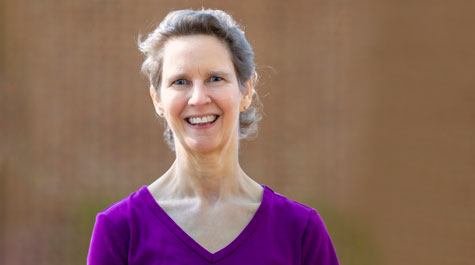W&M professor adapts dance curriculum for remote learning
All three of William & Mary Professor Joan Gavaler’s dance classes this semester have a mix of in-person and remote students.
This has made for challenging, but refreshing, turns in adapting her teaching.
“I didn’t want anyone to be unable to take a dance class,” she said.
Her classes in modern dance, dance composition and Alexander technique have students studying technique, doing projects and learning guided movement. Gavaler has found a way to teach each one remotely.
“Even on Zoom, what is good in terms of what the arts give is that sense of connection — and it’s more important than ever with this kind of distancing,” Gavaler said. “The arts through Zoom give you that chance to re-inhabit your own body, something that is true in person as well.”
{{youtube:medium:right|bD7jQ7og80g, Remote dancing: The creativity continues}}
She explained that mindfulness, awareness, self-care and self-connection combined with expressiveness and the sense of really being seen, heard and clear about what one wants to communicate are all still there.
“It’s the same in person or on Zoom that the strength of the arts is still the strength of the arts, even when we’re in our little boxes,” Gavaler said.
“Things can get fun and playful and energized and connected, and so to me that’s the key thing. Yeah, we’re doing our work; we’re doing our classes. Not only is it not surprising that dance can do this, it’s inherent. This is what we do; we connect. That to me is the key idea.”
Her use of video has evolved as the pandemic has gone on.
After students moved to all remote learning in the spring, Gavaler quickly went into the studio to record herself performing movement for all of their upcoming lessons and did one-on-one instruction with students through Zoom. She continues to use video in two ways this fall — having students record their dance projects for critique by a classmate and then by her, as well as using Zoom to bring remote students into the studio along with masked, physically distanced in-person students for classes.
Student dance project videos show the variety of spaces being used for remote study and instruction, ranging from study lounge to lawn, porch to living room. All are working on the same projects, but use the space readily at hand to complete them, which adds to the choices in creativity.
“The most exciting part about teaching dance composition is that a student can develop their own artistic voice from a variety of dance backgrounds and levels of training,” Gavaler said. “In addition to studying various forms of modern dance at W&M, students in my classes have studied African dance, Indian classical dance, ballet and voguing.”
Kayli Martin ’21 is doing an independent study remotely this semester so that she can finish her dance minor to graduate in the spring. She works with one of the current classes so that she can get feedback and interaction, and attends classes via Zoom.
“This semester's blended teaching has been a very new experience for me,” Martin said. “Having dance class virtually has introduced many new challenges, but I have really enjoyed the focus and versatility that an environment other than a studio has provided.
“I am surprised at how much inspiration I have gained while at home when it comes to my dance courses and look forward to seeing what else new comes along with remote learning.”
Patrick Northrup ’22 is new to dancing, took modern dance classes in the spring and wanted to continue this fall, so he enrolled in Dance Composition I, he said.
“I wasn’t sure what to expect from a choreography class that was being offered online, but it has really exceeded my expectations,” Northrup said. “Joan has designed the class in a way that’s truly accommodating for each student whether they’re in person or virtual. The assignments and studies are sometimes challenging, but the end result is always rewarding.”
He enjoys crafting and performing his own pieces and then receiving feedback from peers when they watch the videos during class, Northrup said.
“This format is especially valuable to me as a newer dancer,” he said. “I still feel as if I’m present in the classroom even though I’m in the comfort of my home. I’ve learned a lot through experimenting both in and outside of class and taking comments and critiques into consideration.
“I’m pleased with my progress in the class so far and am looking forward to continue developing my choreography and movement through the remainder of the semester.”
Students continue to be immersed in learning, wherever they may be.
“I am so grateful that I am able to take this class remotely," said Ellie Palmer ’22. “Dance is obviously a very difficult class to shift to a remote environment, and I am so happy that I still have the opportunity to take this class while being remote, even as most students have returned to campus. I think this class has done a great job of maintaining the educational goals even in these difficult times.
“I have continued to learn a lot about dance even though I am not able to be there in person. Although there are many aspects of movement that aren't really possible right now such as travelling across the floor and partner work, I think the professor has done a great job using this as an opportunity to emphasize other aspects of movement and not letting these new challenges get in the way of the goals of the course.”
 Skip to main content
Skip to main content

